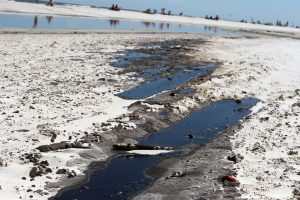
TUSCALOOSA, Ala. — Two University of Alabama biologists are leading a new, three-year, $1.5 million study of the 2010 oil spill’s impact on the northern Gulf of Mexico in an effort to improve responses to future spills.
Dr. Behzad Mortazavi, UA associate professor of biological sciences, and Dr. Patricia Sobecky, associate provost for academic affairs and professor of biological sciences, are part of a multidisciplinary team of scientists conducting the research.
The study focuses on the role biodiversity – the measurement of the variety of organisms in an environment – played in the northern Gulf of Mexico’s ecological recovery.
“Gaining full comprehension of the impacts from both the Deepwater Horizon spill and the subsequent clean-up efforts, including the use of dispersant, will take many years,” said Mortazavi. “Ecosystems are fragile and yet, at times, they can be extremely resilient. We want to continue looking at how the area’s biodiversity may have contributed to its resiliency.”
The $1.5 million study is part of a $6.5 million grant awarded to the Dauphin Island Sea Lab/Marine Environmental Science Consortium by the Gulf of Mexico Research Initiative. Dr. John Valentine, executive director of the Dauphin Island Sea Lab, leads the overall effort.
The UA-led effort will be conducted with scientists at the Dauphin Island Sea Lab, the University of South Alabama, University of South Florida, Florida Gulf Coast University, Northeastern University, Louisiana State University, and Rutgers University and will also include additional UA researchers, including Drs. Robert Martinez and Melanie Beazley, as well as UA graduate students Suja Rajan and Nikaela Flournoy and a number of UA undergraduate students.
“This project exemplifies the importance of strong collaborations and partnerships to effectively manage important problems facing our state,” said Dr. Carl A. Pinkert, UA vice president for research and economic development.
Mortazavi and Sobecky have been studying the spill’s impact since shortly after the April 2010 event, when an oil rig exploded resulting in millions of gallons of oil spilling into the Gulf. They have published a number of their previous findings in the last four years.
“Our study will focus on a vital ecological process, the nitrogen cycle, driven by microbes,” said Sobecky. “In one aspect of the project, we will expand our assessment of how microbes respond to high concentrations of oil and dispersant, especially those microbes carrying out denitrification, a process that causes nitrogen to be removed from the ecosystem and which is only carried out by microbes.
“Our findings could prove helpful in improving society’s ability to respond to future petroleum pollution and will help in developing restoration plans in the Gulf,” Sobecky said.
The Gulf of Mexico Research Initiative is a 10-year research effort established in 2010 and funded by a $500 million commitment by BP. It is administered through an independent research board.
UA’s department of biological sciences is part of the College of Arts and Sciences, UA’s largest division and the largest liberal arts college in the state. Students from the College have won numerous national awards including Rhodes Scholarships, Goldwater Scholarships, Truman Scholarships, and memberships on the USA Today Academic All American Team.
Contact
Chris Bryant, UA media relations, 205/348-8323, cbryant@ur.ua.edu
Source
Dr. Behzad Mortazavi, 251/861-2141 ext. 2189, bmortazavi@ua.edu; Dr. Patricia Sobecky, 205/348-8314, psobecky@ua.edu